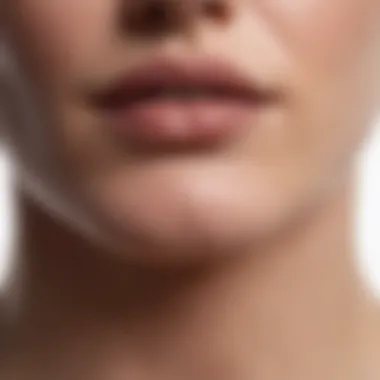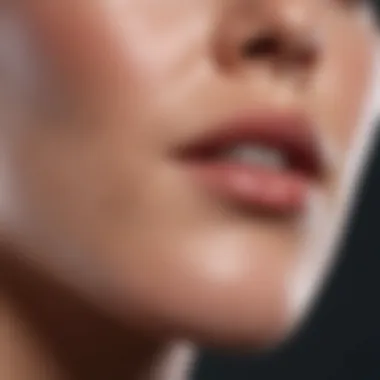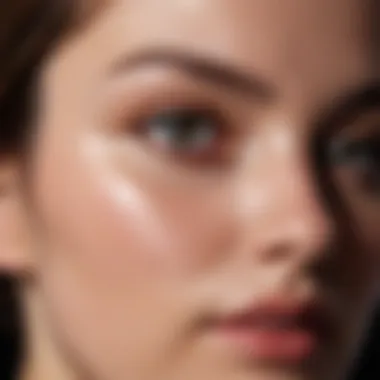Effective Solutions for Ingrown Hair Bumps


Intro
Ingrown hair bumps can be an irritating and often painful issue for many. They occur when hair follicles become clogged or hair grows back into the skin. This can result in red, inflamed bumps that are uncomfortable and can detract from a person's overall appearance. Understanding the causes of ingrown hair bumps is essential to finding effective solutions.
In this article, we will explore the various methods to manage and prevent these skin concerns. We will cover causes, proactive measures, and treatment options. By equipping yourself with knowledge, you can enhance your skincare routine and address ingrown hairs effectively.
Causes of Ingrown Hair Bumps
Ingrown hair bumps commonly result from several factors:
- Shaving: Using dull razors or improper shaving techniques can increase the likelihood of hair growing back into the skin.
- Hair Type: Coarser and curlier hair types are more prone to growing back into the follicle.
- Tight Clothing: Wearing clothes that cling to the skin can trap hair, leading to ingrown hairs.
"Awareness of common causes of ingrown hair bumps is essential for effective prevention."
Prevention Strategies
To avoid the discomfort associated with ingrown hair bumps, consider the following strategies:
- Exfoliation: Regularly exfoliating the skin prevents dead skin cells from clogging hair follicles.
- Proper Shaving Techniques: Use sharp razors and always shave in the direction of hair growth. Avoid dry shaving, as it increases irritation.
- Moisturizing: Keeping the skin hydrated helps protect it from irritation during hair removal practices.
- Wearing Loose Clothing: Opt for more relaxed fit clothing to prevent hair from becoming caught in tight seams.
Effective Treatments
When ingrown hair bumps do appear, several treatments can aid in soothing the skin:
- Warm Compress: Applying a warm compress can reduce inflammation and help the hair break through the skin.
- Topical Treatments: Over-the-counter creams with salicylic acid or glycolic acid can help unclog hair follicles.
- Professional Help: In severe cases, seeking help from a dermatologist can lead to more targeted treatment options.
Closure
Ingrown hair bumps are a common issue, but with understanding and proper care, they can be effectively managed. By implementing preventive measures and being aware of treatment options, individuals can maintain healthier skin. This not only enhances the effectiveness of skincare routines but also boosts confidence in personal appearance.
Understanding Ingrown Hair Bumps
Understanding ingrown hair bumps is crucial for anyone concerned with skin care. These bumps not only affect the aesthetic appeal of the skin but can also lead to discomfort and serious skin issues if not managed properly. This section provides insights into what ingrown hair bumps are, where they commonly occur, and the symptoms associated with them. By familiarizing yourself with these aspects, you can better prevent and treat them, leading to healthier skin and a more enjoyable grooming routine.
Definition and Characteristics
Ingrown hair bumps are small, often painful lumps on the skin that occur when hair grows back into the skin instead of rising up from it. They can appear as red or dark spots and may be surrounded by inflammation. The most common characteristics include:
- Appearance: Usually, they present as small raised bumps that can be red, swollen, and tender.
- Formation: Ingrown hairs result from hair that curls back into the follicle.
- Frequency: They can occur on any part of the body where hair is removed, but are especially common in areas such as the legs, face, and bikini line.
Understanding the definition and characteristics helps identify these bumps promptly, facilitating timely treatment and prevention strategies.
Common Locations on the Body
Ingrown hair bumps frequently appear in specific areas due to the hair removal techniques commonly used. The common locations include:
- Legs: Often seen in women who shave frequently, ingrown hairs can become prevalent after shaving or waxing.
- Bikini Line: This area is particularly susceptible due to the coarse nature of hair and the proximity to tighter-fitting clothing.
- Underarms: Shaving in this sensitive area can lead to ingrown hairs, especially if the hair is coarse.
- Face: Men, especially, can experience ingrown hairs in the beard area, which may be aggravated by shaving techniques.
Understanding these regional tendencies can help target specific preventative measures and treatment options.
Symptoms and Associated Discomfort
The symptoms of ingrown hair bumps can vary in intensity but usually include:
- Redness: Inflammation is commonly present around the bump.
- Swelling: The skin can become swollen making the area feel very uncomfortable.
- Pain or Itching: Many people experience mild to moderate pain or itching, which can be quite bothersome.
- Pus-filled Bumps: In some cases, the bumps can become infected and filled with pus, indicating a need for medical attention.
Feeling discomfort from ingrown hair bumps is not only physically unpleasant but can also impact self-esteem. Recognizing these symptoms is important for pursuing appropriate treatments and consultations when necessary.
Understanding ingrown hair bumps and their characteristics is the first step towards effective prevention and management strategies.
Causes of Ingrown Hair Bumps


Understanding the causes of ingrown hair bumps is crucial for developing effective prevention and treatment strategies. Ingrown hairs occur when hair follicles become clogged or irritated, leading to hair growing back into the skin. Identifying the underlying causes can help in tailoring approaches to reduce their occurrence.
Shaving Techniques
Shaving is a common cause of ingrown hair bumps, particularly when proper techniques are not followed. When hair is cut too close to the skin, it can curl back into the follicle. Using razors with multiple blades contributes to this issue by creating a smoother surface but can lead to more irritation. It is essential to use a single-blade razor and shave in the direction of hair growth. Applying moisturizing shaving gels can also minimize friction and help protect the skin.
Waxing and Hair Removal Methods
Waxing removes hair from the root but can lead to ingrown hairs if done improperly. Skin should be prepared through exfoliation before waxing to prevent hairs from becoming trapped under dead skin cells. Also, using cold compresses after waxing can help soothe irritation, reducing the chance of bumps. Other hair removal methods like depilatory creams may also irritate sensitive skin. Testing products on small areas can help ensure compatibility and reduce skin issues.
Skin Type and Hair Texture
Individual skin type and hair texture play significant roles in the likelihood of ingrown hairs. Coarser or curly hair is prone to curling back into the skin after shaving or waxing. People with sensitive skin types may experience more irritation, increasing the chance of developing bumps. Integrating a nurturing skincare routine with gentle exfoliation can aid in preventing ingrown hair occurrences. Regular moisturizing can keep the skin healthy and resilient against hair growth issues.
"Understanding the causes of ingrown hair bumps helps in selecting the right prevention and treatment measures, ultimately leading to better skin health."
Preventative Measures
Preventing ingrown hair bumps requires a proactive approach to skincare. Understanding the factors that contribute to these undesirable bumps plays a crucial role in avoiding them. Implementing effective preventative measures can not only enhance the appearance of your skin but also significantly improve overall comfort.
Proper Shaving Techniques
Shaving can lead to ingrown hairs, especially if not done carefully. Proper techniques can minimize the risk of these bumps. Start by using a clean, sharp razor designed for your skin type. Always shave in the direction of hair growth, not against it. Shaving against the grain raises the risk of hairs curling back into the skin.
Here are some tips for more effective shaving:
- Hydrate the skin: Use warm water before shaving to open up pores.
- Use shaving cream: Apply a thick layer of shaving cream or gel to protect the skin.
- Avoid repetition: Try not to go over the same area multiple times, which can irritate the skin.
By adopting proper shaving techniques, you reduce friction and irritation, decreasing the chances of developing ingrown hair bumps.
Exfoliation Importance
Exfoliation is another essential measure for preventing ingrown hair bumps. Regularly removing dead skin cells helps to keep hair follicles clear. This reduces the risk that hairs will become trapped beneath the skin's surface.
Consider incorporating exfoliation into your skincare routine:
- Physical exfoliants: Scrubs or brushes can help manually remove skin buildup.
- Chemical exfoliants: Ingredients like glycolic acid or salicylic acid can penetrate the skin more deeply and help prevent clogging of hair follicles.
Aim to exfoliate two to three times a week, depending on your skin's sensitivity. This practice will keep your pores clear and significantly decrease the occurrence of ingrown hair bumps.
Moisturizing and Skin Care Routines
Maintaining a consistent moisturizing routine is vital. Hydrated skin is less prone to irritation. Using a daily moisturizer can help keep skin supple and smooth.
When choosing moisturizers, look for products that suit your skin type. Non-comedogenic options are ideal, as they won’t clog pores. Ingredients like shea butter or hyaluronic acid are excellent choices as they provide hydration without causing irritation.
In addition to moisturizers, consider integrating these products into your routine:
- Soothing lotions: Products that contain aloe vera or chamomile to calm irritated skin.
- Lightweight serums: These can help with skin cell turnover and keep pores clear.
Every element in your skincare regimen contributes to a healthy complexion. By focusing on proper shaving techniques, regular exfoliation, and effective moisturization, you can significantly reduce the occurrence of ingrown hair bumps. Protecting your skin not only enhances its appearance but also fosters confidence in your beauty regimen.
Home Remedies for Ingrown Hair Bumps
Home remedies for ingrown hair bumps play a vital role in their management. They provide accessible, cost-effective solutions that can alleviate discomfort while promoting healing. Many individuals prefer these methods because they reduce reliance on pharmaceuticals. Furthermore, natural remedies often minimize the risk of side effects. Incorporating these remedies into your skincare routine can enhance skin health, leading to smoother and clearer skin.
Natural Exfoliants
Natural exfoliants are crucial in addressing ingrown hair bumps. Regular exfoliation helps remove dead skin cells that can trap hairs under the skin’s surface. This simple process facilitates hair growth in the right direction and minimizes bumps. Common natural exfoliants include sugar, salt, and oatmeal. Combining these with oils like olive or coconut creates a gentle scrub. Rub this mixture on affected areas in circular motions to enhance blood circulation while gently shedding layers of dead skin.
Warm Compress Applications


Applying a warm compress can be a soothing remedy for ingrown hair bumps. This method works by softening the skin and opening pores, which can allow trapped hairs to emerge. To use this approach, soak a clean cloth in warm water. Wring out the excess water, and apply the warm cloth to the area for about fifteen minutes. Repeat this process two to three times daily until the ingrown hair bumps resolve. This easy remedy provides both relief and potential healing benefits.
Tea Tree Oil Benefits
Tea tree oil is renowned for its antiseptic and anti-inflammatory properties. Its application can effectively reduce swelling and redness associated with ingrown hair bumps. To use it, dilute a few drops of tea tree oil in a carrier oil, such as jojoba or almond oil. Apply this mixture directly to the bumps using a cotton ball. Doing this once or twice daily can hasten healing. However, it is advisable to perform a patch test first to check for any allergic reactions.
Aloe Vera for Soothing Skin
Aloe vera is a natural remedy rich in vitamins and soothing properties. It is beneficial for calming irritated skin and accelerating healing. To use aloe vera, simply extract fresh gel from the plant’s leaves. Apply this gel directly to the inflamed areas and leave it on for at least twenty minutes before rinsing. Regular application can help soothe discomfort and promote skin repair. Additionally, aloe vera hydrates the skin, which can prevent future bumps in the long run.
"Natural remedies provide an accessible path to skin health without the associated risks of conventional treatments."
In summary, home remedies for ingrown hair bumps offer practical solutions. Combining natural exfoliants, warm compresses, tea tree oil, and aloe vera can significantly improve skin condition. By integrating these methods into one’s routine, individuals can manage and prevent ingrown hair bumps effectively.
Over-the-Counter Treatments
Over-the-counter treatments are essential in managing ingrown hair bumps. These products can provide relief from irritation and promote healing. They are often readily available at pharmacies or supermarkets, making them accessible for those looking for quick solutions. The right over-the-counter treatment can significantly reduce the discomfort of ingrown hair bumps, aiding the overall skincare routine.
Exfoliating Products
Exfoliating products play a crucial role in preventing and treating ingrown hair bumps. They work by removing dead skin cells that can clog hair follicles. This process allows hairs to grow freely, reducing the risk of ingrowth. Common exfoliating options include body scrubs containing physical exfoliants like sugar or salt, and chemical exfoliants such as glycolic acid and salicylic acid.
When choosing an exfoliating product, consider your skin type. For sensitive skin, opt for gentler formulations. Regular use can promote healthier skin and minimize the occurrence of ingrown hairs. Additionally, look for products that are dermatologist-recommended for added reassurance.
Topical Treatments
Topical treatments serve to directly address the inflammation and discomfort associated with ingrown hair bumps. Many of these products contain active ingredients such as benzoyl peroxide, which helps to reduce bacteria on the skin. Others contain salicylic acid, known for its anti-inflammatory properties that can ease swelling and redness.
Applying these treatments to the affected area can help speed up the healing process. However, always perform a patch test to avoid unwanted reactions. Consistency is key; using these topical treatments regularly can help maintain skin clarity and prevent future issues related to ingrown hairs.
Anti-inflammatory Solutions
Anti-inflammatory solutions are vital when dealing with ingrown hair bumps. Such treatments aim to reduce swelling and discomfort. Over-the-counter options include hydrocortisone cream, which can alleviate itching and inflammation. Another option is using products containing chamomile or calendula, known for their soothing properties.
"Using anti-inflammatory solutions can help make the healing process more bearable and improve overall skin appearance."
Before applying these products, it is important to cleanse the area to avoid trapping dirt and bacteria, which can worsen the situation. Always follow the instructions provided with the product for best results, and consult with a dermatologist if irritation persists.
Professional Treatments
When conventional home remedies and over-the-counter solutions do not alleviate ingrown hair bumps, professional treatments become a valuable option. These interventions are important not only for providing effective relief but also for addressing deeper skin issues that can arise from persistent ingrown hairs. Thus, seeking assistance from skin care professionals can yield significant benefits for long-term management of this condition.
Dermatological Procedures
Dermatological procedures are often recommended for severe cases of ingrown hair bumps. These procedures are typically conducted by qualified dermatologists who can assess the condition of the skin accurately. Various methods are available, such as lancing or excision, where the dermatologist carefully opens the bump to release the trapped hair. This can provide immediate relief from discomfort and accelerate the healing process.
Moreover, dermatologists may also utilize extraction techniques that minimize scarring and ensure the skin remains as healthy as possible. They may apply topical antiseptics afterwards to prevent potential infections, making this a safe option for treatment.
An important factor to consider when opting for any dermatological procedure is the experience of the practitioner. Research their qualifications and seek reviews or recommendations from other patients. This helps ensure you receive the best care tailored to your individual skin type and condition.
Laser Hair Removal Considerations
Laser hair removal has become a popular choice for long-term resolution of ingrown hair bumps. This method involves using targeted laser technology that destroys hair follicles, preventing future hair growth. One significant benefit of laser hair removal is its precision; the laser can distinguish between hair and surrounding skin, minimizing damage to the surrounding tissues.
It's essential to weigh the pros and cons before deciding on laser treatments. The sessions often require multiple visits, making it a time-consuming option. Moreover, the cost of laser hair removal can be higher than other treatments. However, many women find that the long-term benefits, such as smooth skin and reduced ingrown hair incidences, justify the investment.
Remember to consult a trained and licensed technician, as improper use of laser technology can lead to skin burns or pigmentation changes.
Chemical Peels for Prevention
Chemical peels serve as another professional option in preventing future ingrown hair bumps. During a chemical peel, a solution is applied to the skin, which exfoliates the uppermost layers. This process promotes cell turnover and helps eliminate dead skin cells that can clog hair follicles and contribute to ingrown hairs.


There are different strengths of chemical peels available, ranging from superficial to deep. A superficial peel might be sufficient for mild cases and can often be done during a routine dermatological visit. On the other hand, deep peels may require more recovery time but can provide more dramatic results for chronic conditions.
Consider the type of peel that aligns with your skin type and sensitivity. Discuss the potential risks and expected outcomes with your dermatologist to ensure an informed decision. Using chemical peels as part of a regular skincare routine can enhance overall skin texture while simultaneously reducing the likelihood of ingrown hair bumps.
Key Takeaway: Professional treatments offer specific solutions for persistent ingrown hair bumps. They can provide long-term benefits, preventing not just discomfort but also the recurrence of this common skin issue.
Uncommon and Severe Cases
When dealing with ingrown hair bumps, it is essential to recognize that while many cases are mild and manageable, some can escalate into uncommon and severe situations. Understanding these rare occurrences is critical for effective skincare and early intervention. This section aims to highlight signs that may indicate a more serious condition, as well as guidance on when to seek professional medical advice.
Infection Signs
In rare cases, an ingrown hair bump can become infected. This situation typically arises when bacteria enter the area, leading to inflammation and pus formation. Recognizing the signs of infection is crucial for timely treatment.
Signs that may indicate an infection include:
- Increased redness around the bump that spreads beyond the immediate area.
- Swelling and heat emanating from the affected site, indicating inflammation.
- Pus or discharge, which may be yellow or green in color, instead of clear.
- Pain or tenderness that intensifies over time, rather than improving.
- Fever, which can signify that the body is combating an infection.
If any of these symptoms appear, it is imperative to seek medical attention promptly. Infections, if left untreated, can lead to more severe health issues.
When to Seek Medical Advice
It is important to consult a medical professional if there are signs of complications or if discomfort persists beyond a reasonable timeframe. Knowing when to reach out for help can prevent further complications and support effective treatment.
Consider seeking medical advice if:
- There is persistent pain or discomfort surrounding the ingrown hair bump that does not improve within a few days.
- The bump shows no signs of improvement after attempting home treatments.
- You notice any systemic symptoms, such as fever or chills.
- The bump becomes increasingly swollen or red, suggesting possible infection.
- There is significant discharge that worsens over time.
Long-Term Management Strategies
Long-term management of ingrown hair bumps is essential for both prevention and treatment. Developing a consistent routine not only reduces the frequency of these bumps but also enhances skin health over time. Such strategies empower individuals to take control of their skincare.
Adopting a Consistent Routine
Creating a routine requires dedication but brings significant benefits. A daily skincare regimen that includes cleansing, exfoliating, and moisturizing can greatly reduce the incidence of ingrown hairs. The key is consistency.
- Cleansing: Use a gentle cleanser suitable for your skin type to remove dirt and oil. This helps prevent hair follicles from becoming clogged.
- Exfoliating: Incorporate exfoliation into your routine several times a week. This can be done physically with scrubs or chemically using products containing salicylic or glycolic acid. Regular exfoliation removes dead skin cells, allowing hairs to grow out instead of curling back.
- Moisturizing: Always follow up cleansing and exfoliating with a good moisturizer. Products containing hyaluronic acid or glycerin can keep the skin hydrated and supple.
By arranging these steps into a daily practice, skin integrity improves, and ingrown hairs become less frequent.
Product Recommendations
Choosing the right products is fundamental for successful long-term management. Here are a few recommended types that can enhance your routine:
- Exfoliating Scrubs: Look for products with natural ingredients like sugar or coffee grounds, as they can be gentle yet effective at sloughing off dead skin.
- Chemical Exfoliants: Products with salicylic acid help penetrate pores and are adept at breaking down the bonds between dead skin cells.
- Moisturizers: Select creams that support skin barrier function; options with ceramides or essential fatty acids can add hydrating and protective benefits.
Always be cautious and patch test new products to avoid unwanted reactions.
"Prevention is always better than cure. Establishing a routine will save time and discomfort in the long run."
In summary, a personalized long-term plan that includes adopting a consistent skincare routine and utilizing the right products is crucial. The focus should be on maintaining healthy skin, enhancing comfort, and reducing the risk of ingrown hair bumps.
Ending
In this article, we have explored various facets of ingrown hair bumps, providing an in-depth understanding of their causes, prevention strategies, and treatment options. Ingrown hair bumps can present significant discomfort and aesthetic concerns. This topic is relevant for many, particularly for women who seek effective methods to manage their skin health.
Recap of Key Points
- Ingrown hair bumps occur when hairs grow back into the skin, often causing redness and irritation.
- Common causes include shaving techniques, types of hair removal, and skin type.
- Preventative measures such as proper shaving, exfoliation, and moisturizing are essential.
- Various home remedies can provide relief, with natural ingredients like aloe vera and tea tree oil being particularly beneficial.
- Over-the-counter treatments can assist in addressing symptoms, while more severe cases may require professional medical advice.
It's crucial to understand these elements for effective management of ingrown hair bumps. Taking proactive steps helps minimize their occurrence and can improve overall skin health.
Final Thoughts on Prevention and Care
Preventing ingrown hair bumps is not merely a matter of addressing existing issues; it's about creating a holistic approach to skincare. Maintaining a consistent routine that emphasizes proper hair removal techniques and regular skin care is key.
Consider integrating natural products into your regimen, as they can promote better skin health without harsh chemicals. Regular exfoliation, hydration, and awareness of your skin’s unique needs will markedly reduce the prevalence of ingrown hairs.
In summary, awareness of the causes and treatments, combined with diligent skincare habits, leads to effective management. As you implement these strategies, you will empower yourself to not only address ingrown hair bumps but also enhance your overall skin health.



